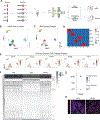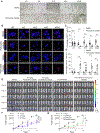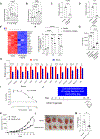A pancreatic cancer organoid platform identifies an inhibitor specific to mutant KRAS
- PMID: 38151022
- PMCID: PMC11022279
- DOI: 10.1016/j.stem.2023.11.011
A pancreatic cancer organoid platform identifies an inhibitor specific to mutant KRAS
Abstract
KRAS mutations, mainly G12D and G12V, are found in more than 90% of pancreatic ductal adenocarcinoma (PDAC) cases. The success of drugs targeting KRASG12C suggests the potential for drugs specifically targeting these alternative PDAC-associated KRAS mutations. Here, we report a high-throughput drug-screening platform using a series of isogenic murine pancreatic organoids that are wild type (WT) or contain common PDAC driver mutations, representing both classical and basal PDAC phenotypes. We screened over 6,000 compounds and identified perhexiline maleate, which can inhibit the growth and induce cell death of pancreatic organoids carrying the KrasG12D mutation both in vitro and in vivo and primary human PDAC organoids. scRNA-seq analysis suggests that the cholesterol synthesis pathway is upregulated specifically in the KRAS mutant organoids, including the key cholesterol synthesis regulator SREBP2. Perhexiline maleate decreases SREBP2 expression levels and reverses the KRAS mutant-induced upregulation of the cholesterol synthesis pathway.
Keywords: KRAS; SREBP2; cholesterol biosynthesis; colon cancer organoids; lung cancer organoids; orthotopic transplantation; pancreatic organoid; perhexiline maleate; targeted therapy.
Copyright © 2023 Elsevier Inc. All rights reserved.
Conflict of interest statement
Declaration of interests S.C. and T.E. are the co-founders of OncoBeat, LLC. S.C. is a consultant for Vesalius Therapeutics. F.C.P. is currently employed by Exelixis.
Figures







Comment in
-
The KRAS tour: Studying metabolic reprogramming in isogenic pancreatic cancer organoids.Cell Stem Cell. 2024 Jan 4;31(1):1-2. doi: 10.1016/j.stem.2023.12.010. Cell Stem Cell. 2024. PMID: 38181746
References
-
- Sato T, Stange DE, Ferrante M, Vries RG, Van Es JH, Van den Brink S, Van Houdt WJ, Pronk A, Van Gorp J, Siersema PD, and Clevers H. (2011). Long-term expansion of epithelial organoids from human colon, adenoma, adenocarcinoma, and Barrett’s epithelium. Gastroenterology 141, 1762–1772. 10.1053/j.gastro.2011.07.050. - DOI - PubMed
-
- Li X, Francies HE, Secrier M, Perner J, Miremadi A, Galeano-Dalmau N, Barendt WJ, Letchford L, Leyden GM, Goffin EK, et al. (2018). Organoid cultures recapitulate esophageal adenocarcinoma heterogeneity providing a model for clonality studies and precision therapeutics. Nat Commun 9, 2983. 10.1038/s41467-018-05190-9. - DOI - PMC - PubMed
-
- Bartfeld S, Bayram T, van de Wetering M, Huch M, Begthel H, Kujala P, Vries R, Peters PJ, and Clevers H. (2015). In vitro expansion of human gastric epithelial stem cells and their responses to bacterial infection. Gastroenterology 148, 126–136 e126. 10.1053/j.gastro.2014.09.042. - DOI - PMC - PubMed
-
- Broutier L, Mastrogiovanni G, Verstegen MM, Francies HE, Gavarro LM, Bradshaw CR, Allen GE, Arnes-Benito R, Sidorova O, Gaspersz MP, et al. (2017). Human primary liver cancer-derived organoid cultures for disease modeling and drug screening. Nat Med 23, 1424–1435. 10.1038/nm.4438. - DOI - PMC - PubMed
Publication types
MeSH terms
Substances
Grants and funding
LinkOut - more resources
Full Text Sources
Medical
Miscellaneous

